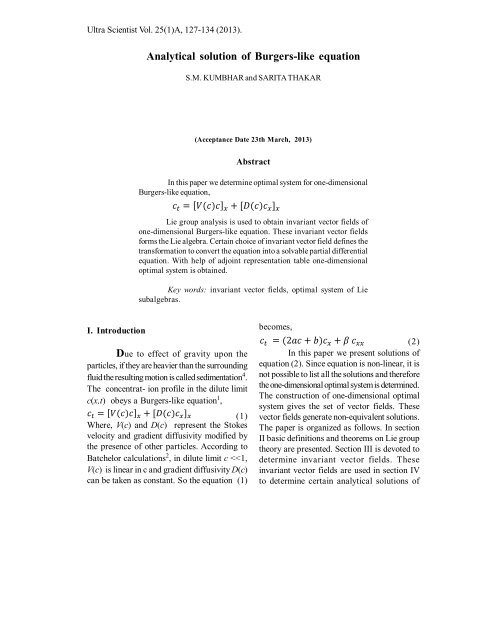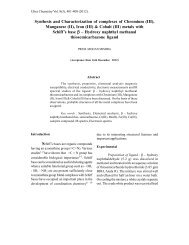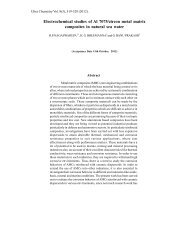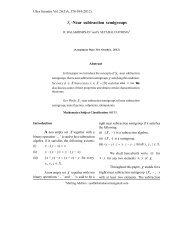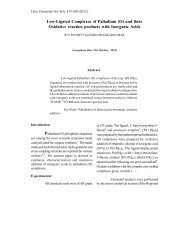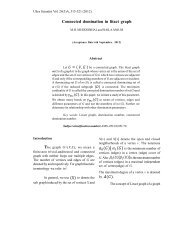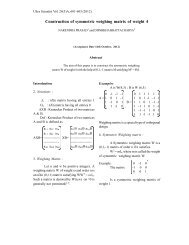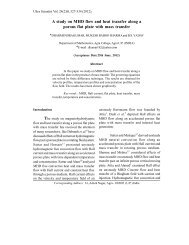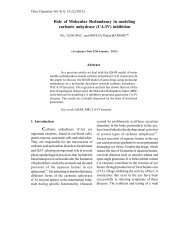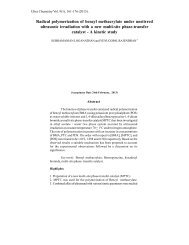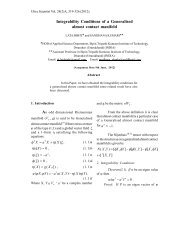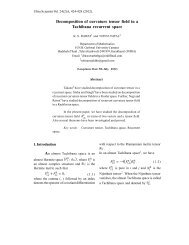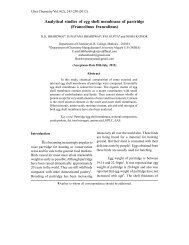Analytical solution of Burgers-like equation - Ultrascientist.org
Analytical solution of Burgers-like equation - Ultrascientist.org
Analytical solution of Burgers-like equation - Ultrascientist.org
You also want an ePaper? Increase the reach of your titles
YUMPU automatically turns print PDFs into web optimized ePapers that Google loves.
Ultra Scientist Vol. 25(1)A, 127-134 (2013).<br />
<strong>Analytical</strong> <strong>solution</strong> <strong>of</strong> <strong>Burgers</strong>-<strong>like</strong> <strong>equation</strong><br />
S.M. KUMBHAR and SARITA THAKAR<br />
(Acceptance Date 23th March, 2013)<br />
Abstract<br />
In this paper we determine optimal system for one-dimensional<br />
<strong>Burgers</strong>-<strong>like</strong> <strong>equation</strong>,<br />
Lie group analysis is used to obtain invariant vector fields <strong>of</strong><br />
one-dimensional <strong>Burgers</strong>-<strong>like</strong> <strong>equation</strong>. These invariant vector fields<br />
forms the Lie algebra. Certain choice <strong>of</strong> invariant vector field defines the<br />
transformation to convert the <strong>equation</strong> into a solvable partial differential<br />
<strong>equation</strong>. With help <strong>of</strong> adjoint representation table one-dimensional<br />
optimal system is obtained.<br />
Key words: invariant vector fields, optimal system <strong>of</strong> Lie<br />
subalgebras.<br />
I. Introduction<br />
Due to effect <strong>of</strong> gravity upon the<br />
particles, if they are heavier than the surrounding<br />
fluid the resulting motion is called sedimentation 4 .<br />
The concentrat- ion pr<strong>of</strong>ile in the dilute limit<br />
c(x,t) obeys a <strong>Burgers</strong>-<strong>like</strong> <strong>equation</strong> 1 ,<br />
(1)<br />
Where, V(c) and D(c) represent the Stokes<br />
velocity and gradient diffusivity modified by<br />
the presence <strong>of</strong> other particles. According to<br />
Batchelor calculations 2 , in dilute limit c
128 S.M. Kumbhar, et al.<br />
<strong>equation</strong> (2). In section V, adjoint representation<br />
table is constructed and is used to determine<br />
one-dimensional optimal system. Conclusions<br />
are given at the end.<br />
II. Preliminaries:<br />
In this section we state the basic<br />
definitions and theorems on symmetry group<br />
and Lie algebra 3 .<br />
i) The General Prolongation formula: Let<br />
ii) Theorem 1: Suppose<br />
, ,<br />
is a system <strong>of</strong> differential <strong>equation</strong>s <strong>of</strong> maximal<br />
rank defined over<br />
. If G is a local<br />
group <strong>of</strong> transformations acting on M, and<br />
, whenever ,<br />
for every infinitesimal generator <strong>of</strong> G, then<br />
G is a symmetry group <strong>of</strong> the system.<br />
III. Invariant vector fields:<br />
be a vector field defined on an open subset<br />
MX U. The n th prolongation <strong>of</strong> is the vector<br />
field<br />
(3)<br />
In this section we determine invariant<br />
vector fields for <strong>equation</strong> (2). On applying<br />
theorem 1 and general prolongation formula<br />
(3), we determine the symmetry group <strong>of</strong><br />
<strong>equation</strong> (2). Suppose the symmetry group <strong>of</strong><br />
<strong>equation</strong> (2) is generated by vector field,<br />
defined on the corresponding jet space<br />
, the second summation being<br />
over all multi-indices ,<br />
with , . The coefficient<br />
functions <strong>of</strong> are given by the<br />
formula:<br />
On applying the second prolongation <strong>of</strong> vector<br />
field on <strong>equation</strong> (2) we get,<br />
where,<br />
where, and .
<strong>Analytical</strong> <strong>solution</strong> <strong>of</strong> <strong>Burgers</strong>-<strong>like</strong> <strong>equation</strong>. 129<br />
The generators are functions<br />
<strong>of</strong> t, x, c and are independent <strong>of</strong> partial<br />
derivatives <strong>of</strong> c with respect to t and x. On<br />
substituting the expression for<br />
in<br />
<strong>equation</strong> (5) and on equating the coefficients<br />
<strong>of</strong> equal powers <strong>of</strong> partial derivatives <strong>of</strong> c w.r.t.<br />
x and t we get the following system <strong>of</strong><br />
<strong>equation</strong>s.<br />
The commutation relations between<br />
vector fields are given by the following table 1.<br />
The entry in row i and column j representing<br />
and is defined as<br />
On simultaneous evaluation <strong>of</strong> above system<br />
<strong>of</strong> <strong>equation</strong>s we get,<br />
.<br />
.<br />
Table 1. Commutator table for 5 parameter<br />
Lie algebra<br />
1 2 3 4 5<br />
1 0 0 2 1 2 1<br />
2 0 0 0 3<br />
3 2 0 0 3 0<br />
4 1 2 3 0 5<br />
where<br />
.<br />
are arbitrary constants.<br />
With respect to each constant C i we get an<br />
invariant vector field. Thus the Lie algebra is<br />
generated by the following five vector fields.<br />
5 4 3 0 5 0<br />
Since the set <strong>of</strong> invariant vector fields<br />
forms a linear space any linear combination<br />
<strong>of</strong> these vectors is also an invariant vector<br />
field. In section IV we determine <strong>solution</strong>s <strong>of</strong><br />
<strong>equation</strong> (2) by using invariant vector fields<br />
5 and 1 + 5 .
130 S.M. Kumbhar, et al.<br />
IV. <strong>Analytical</strong> <strong>solution</strong>:<br />
In this section we determine some<br />
<strong>solution</strong>s <strong>of</strong> <strong>equation</strong> (2). To determine the<br />
analytic <strong>solution</strong> <strong>of</strong> <strong>equation</strong> (2) vector field 5<br />
is used to define new independent and<br />
dependent variables. Correspond to vector<br />
field 5 we get the characteristic <strong>equation</strong><br />
We define new independent variables as<br />
(9)<br />
(10)<br />
this leads to a system <strong>of</strong> ordinary differential<br />
<strong>equation</strong>s,<br />
and<br />
From above characteristic <strong>equation</strong> define new<br />
variables , and<br />
In the phase plane we get<br />
We treat µ as new<br />
dependent variable. Since, and θ are functions<br />
<strong>of</strong> x and t we treat and θ as new independent<br />
variables. With this choice <strong>of</strong> new variables<br />
<strong>equation</strong> (2) becomes,<br />
(6)<br />
Equation (6) is a standard onedimensional<br />
<strong>Burgers</strong> <strong>equation</strong>. Here, we use<br />
First integral method 1 to find analytical <strong>solution</strong><br />
<strong>of</strong> <strong>equation</strong> (6). We use transformation<br />
By integrating above <strong>equation</strong>, we get<br />
where k 1 is integrating constant.<br />
On integrating above differential <strong>equation</strong>, we<br />
get<br />
where k 2 is integrating constant and<br />
, where (7)<br />
Then by using chain rule,<br />
But<br />
X = µ and<br />
(8)<br />
therefore, we have<br />
With the representation given in <strong>equation</strong> (7)<br />
<strong>equation</strong> (6) gets converted in to an ordinary<br />
differential <strong>equation</strong><br />
(11)
<strong>Analytical</strong> <strong>solution</strong> <strong>of</strong> <strong>Burgers</strong>-<strong>like</strong> <strong>equation</strong>. 131<br />
which is analytical <strong>solution</strong> <strong>of</strong> <strong>equation</strong> (2).<br />
The <strong>solution</strong> (11) obtained from vector<br />
field 5 is defined for t > 0. Non-singular <strong>solution</strong><br />
<strong>of</strong> <strong>equation</strong> (2) is obtained from vector field<br />
1 + 5 . The characteristic <strong>equation</strong> corresponding<br />
to the vector field 1 + 5 is<br />
From the above characteristic <strong>equation</strong> define<br />
new independent variables and as = tan -1<br />
On equating the coefficients <strong>of</strong> equal powers<br />
<strong>of</strong> we get k() and k 1 () as follows<br />
and<br />
Where, c 1 and c 2 are constants <strong>of</strong> integration.<br />
Thus from <strong>equation</strong> (13) we get<br />
t and<br />
. And the new dependent<br />
Since<br />
we have<br />
variable denoted by µ is defined as<br />
with this choice <strong>of</strong> new variables, <strong>equation</strong> (2)<br />
becomes<br />
(15)<br />
Another <strong>solution</strong> <strong>of</strong> <strong>equation</strong> (12) can be obtained<br />
by assuming that<br />
(16)<br />
Since <strong>equation</strong> (16) is <strong>solution</strong> <strong>of</strong> <strong>equation</strong> (12),<br />
we get<br />
Equation (12) is purely non-linear and different<br />
functional forms will provides different<br />
<strong>solution</strong>s to <strong>equation</strong> (12). In this section we<br />
report two different <strong>solution</strong>s.<br />
Suppose,<br />
then (13)<br />
Since , <strong>equation</strong> (12)<br />
becomes<br />
From <strong>equation</strong> (13) and (14) we get,<br />
(14)<br />
On equating the coefficients <strong>of</strong> equal powers<br />
<strong>of</strong> we get and as follows<br />
and<br />
where c 3<br />
is constant <strong>of</strong> integration.<br />
Thus from <strong>equation</strong> (16) we get<br />
Since<br />
we have
132 S.M. Kumbhar, et al.<br />
V. One dimensional optimal system:<br />
In section IV we have seen that there<br />
are many <strong>solution</strong>s available for <strong>equation</strong> (2)<br />
and it necessary to classify all <strong>solution</strong>s into<br />
different categories. This classification is achieved<br />
by constructing one dimensional optimal<br />
system. The problem <strong>of</strong> finding an optimal<br />
system <strong>of</strong> subgroups is equivalent to that <strong>of</strong><br />
finding an optimal system <strong>of</strong> subalgebras. For<br />
one-dimensional subalgebra this classification<br />
is essentially the same as the problem <strong>of</strong><br />
classifying the orbits <strong>of</strong> the adjoint representation.<br />
From the commutator table we obtain the<br />
adjoint representation table 2. To compute<br />
adjoint representation we use the Lie series<br />
For finding one-dimensional optimal system,<br />
we consider<br />
Suppose without loss <strong>of</strong> generality let<br />
. If we act on such a by ,<br />
then we can make the coefficient <strong>of</strong> v 3 vanish<br />
and we get<br />
The coefficients<br />
are<br />
functions <strong>of</strong><br />
. Next we act on v'<br />
by<br />
<strong>of</strong> v 4 , leading to<br />
to cancel the coefficient<br />
Table 2. Adjoint representation <strong>of</strong> Lie<br />
subalgebra <strong>of</strong> dimension 5<br />
Ad 1 2 3 4 5<br />
1 1 2 3 4 5<br />
2 1 4<br />
1<br />
2 1 2 3 4 5 <br />
For certain depending on .<br />
Next we act on v" by<br />
to<br />
eliminate the coefficient v 2 , leading to<br />
3<br />
3 1 2 3 4 + 5<br />
2 3<br />
4 1 4<br />
5 1 + 2 3 4<br />
4 + 3 5 5<br />
5<br />
For certain depending on . we can<br />
further act on v'" by<br />
. This has<br />
the net effect <strong>of</strong> scaling the coefficients <strong>of</strong> v 1<br />
and v 5<br />
We can make the coefficient <strong>of</strong> v 1 either or<br />
+1,1 or 0. Then one-dimensional subalgebras
<strong>Analytical</strong> <strong>solution</strong> <strong>of</strong> <strong>Burgers</strong>-<strong>like</strong> <strong>equation</strong>. 133<br />
spanned by a general vector field v with a 5 0<br />
is equivalent to an algebra spanned by {v 1 +v 5 ,<br />
v 1 + v 1 + v 5, + v 5 }.<br />
The remaining one-dimensional<br />
subalgebras are spanned by vectors <strong>of</strong> the<br />
form<br />
If we act on such a v by Ad (exp (a 1 v 1 )), we<br />
can make the coefficient <strong>of</strong> v 1 vanish and we<br />
get<br />
For certain<br />
we act on v' by<br />
the coefficient v 2 , leading to<br />
depending on a 1 ,a 2 ,a 3 . Next<br />
to cancel<br />
further act on v' by<br />
. this<br />
operation has the net effect <strong>of</strong> scaling the<br />
coefficients <strong>of</strong> v 1 and v 3<br />
We can make the coefficient <strong>of</strong> v 1<br />
either +1,1 or 0. Then one-dimensional<br />
subalgebras generated by v with a 5 =a 4 =0, a 3 0<br />
is equivalent to an algebra spanned by {v 1 +v 3,<br />
v 1 +v 3, v 3 <br />
The remaining one-dimensional<br />
subalgebras are spanned by vectors <strong>of</strong> the<br />
above form with a 5 =a 4 =a 3 0, a 2 0 and a 2 =1,<br />
v becomes,<br />
For certain depending on . Next<br />
If we act on such a v by<br />
we act on v" by<br />
cancel the coefficient v 3 , leading to<br />
to<br />
then the coefficient <strong>of</strong> v 2 vanish:<br />
Every one-dimensional subalgebra generated<br />
by v with<br />
algebra spanned by {v 4 }.<br />
is equivalent to the<br />
Similarly with anda 3 =1,<br />
we get<br />
Every one-dimensional subalgebra<br />
generated by v with a 5 =a 4 =a 3 0, a 2 0 is<br />
equivalent to the algebra spanned by {v 1 }.<br />
Thus the optimal system <strong>of</strong> onedimensional<br />
subalgebras are spanned by<br />
If we act on such a v by ,<br />
we can make the coefficient <strong>of</strong> v 2 vanish<br />
For certain depending on We can
134 Ultra Scientist Vol.25(1)A, (2013).<br />
invariant in time as well as in space coordinates.<br />
A singular <strong>solution</strong> <strong>of</strong> <strong>equation</strong> (2)<br />
is obtained from vector field. Two <strong>solution</strong>s<br />
are obtained by using a linear combination <strong>of</strong><br />
two vector fields and first integral method.<br />
Optimal system consisting <strong>of</strong> eight onedimensional<br />
subalgebras is obtained. The<br />
generators <strong>of</strong> there subalgebras are listed at<br />
the end.<br />
References<br />
Conclusion<br />
The symmetry algebra <strong>of</strong> Burger-<strong>like</strong><br />
<strong>equation</strong> (2) is spanned by five vector fields.<br />
The <strong>solution</strong>s <strong>of</strong> <strong>equation</strong> (2) are translation<br />
1. A.J.S. Al-Saif and Ammar Abdul-Hussein,<br />
Generating exact <strong>solution</strong>s <strong>of</strong> two<br />
dimensional coupled <strong>Burgers</strong> <strong>equation</strong>s<br />
by the first integral method, Research<br />
Journal <strong>of</strong> physical and applied science<br />
Vol. 1(2), pp 029-033, (November 2012).<br />
2. L. V. Ovsiannikov, Group Analysis <strong>of</strong><br />
Differential Equations, Academic Press,<br />
(1982).<br />
3. P. J. Olver, Applications <strong>of</strong> Lie groups to<br />
differential <strong>equation</strong>s, Springer–Verlag,<br />
New York (1986).<br />
4. Sergei E. Esipov, Coupled <strong>Burgers</strong><br />
<strong>equation</strong>s: A model <strong>of</strong> polydispersive<br />
sedimentation, Physical review E, Volume<br />
52, Number 4, (Octomber 1995).


